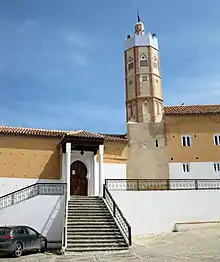Grand Mosque of Chefchaouen
The Grand Mosque of Chefchaouen (Arabic: الأعظم المسجد, romanized: masjid al-ʾaʿaẓam;[1] or الجامع الكبير al-jama ʿal-kabir or الجامع الأكبر al-jamaʿ al-ʾakbar[2]) is the oldest mosque and the main historic Friday mosque of Chefchaouen, Morocco. It is located at the central Place Outa Hammam, near the city's historic kasbah.
| Grand Mosque of Chefchaouen | |
|---|---|
الأعظم المسجد | |
 The entrance and the minaret of the Grand Mosque, from Place Outa Hammam. | |
| Religion | |
| Sect | Sunni |
| Location | |
| Location | Chefchaouen, Morocco |
| Geographic coordinates | 35°10′6.35″N 5°15′44.4″W |
| Architecture | |
| Type | mosque |
| Style | Moroccan, Islamic |
| Founder | Moulay 'Ali ibn Rashid al-Alami or his son Moulay Mohamed ibn 'Ali ibn Rashid al-Alami |
| Date established | late 15th or 16th century (1471 or after) |
| Minaret(s) | 1 |
History

The mosque dates from the earliest period of the city after its foundation by Moulay 'Ali ibn Rashid al-Alami, but sources vary (or contradict each other) in citing the exact date of its foundation: some date it to 1471 (the date of the city's foundation),[1] another cites 1475-76 (880 AH),[3] and others date it to the 16th century,[4][5] particularly under Moulay 'Ali's son Mohammed.[6] Its minaret is believed to date from the late 17th century due to its octagonal shaft and overall similarity to the style of minarets built under Ali ibn Abdallah Errifi (the governor of Tangier under Sultan Moulay Isma'il) such as those of the Kasbah Mosque of Tangier or the Great Mosque of Asilah.[6]
Historically, the mosque also offered lessons in religious sciences such as fiqh (Islamic jurisprudence) and was accompanied by a dormitory for students.[1] As the city's main Friday mosque, it was also the location where the local rulers or governors of Chefchaouen would pledge their allegiance to the Sultan of Morocco and where the decrees of the latter were read publicly.[1] The mosque was restored in the 19th century and again in the 20th century (when the current portal of its main entrance was built).[6] It was most recently restored in 2006.[1]
See also
References
- Hamouda. "La Grande Mosquée de chefchaouen". habous.gov.ma (in French). Retrieved 2020-04-12.
- "Jama' al-Kebir". Archnet. Retrieved 2020-04-12.
- Gaudio, Attilio (1981). Maroc du nord: cités andalouses et montagnes berbères. Paris: Nouvelles Éditions Latines. pp. 92–94.
- "BCmed". www.bcmediterranea.org. Retrieved 2020-04-12.
- Yabiladi.com. "Histoire : Lorsque les Nasrides andalous firent de Chefchaouen leur forteresse". www.yabiladi.com (in French). Retrieved 2020-04-12.
- Touri, Abdelaziz; Benaboud, Mhammad; Boujibar El-Khatib, Naïma; Lakhdar, Kamal; Mezzine, Mohamed (2010). Le Maroc andalou : à la découverte d'un art de vivre (2 ed.). Ministère des Affaires Culturelles du Royaume du Maroc & Museum With No Frontiers. ISBN 978-3902782311.
| Wikimedia Commons has media related to Grand Mosque of Chefchaouen. |

